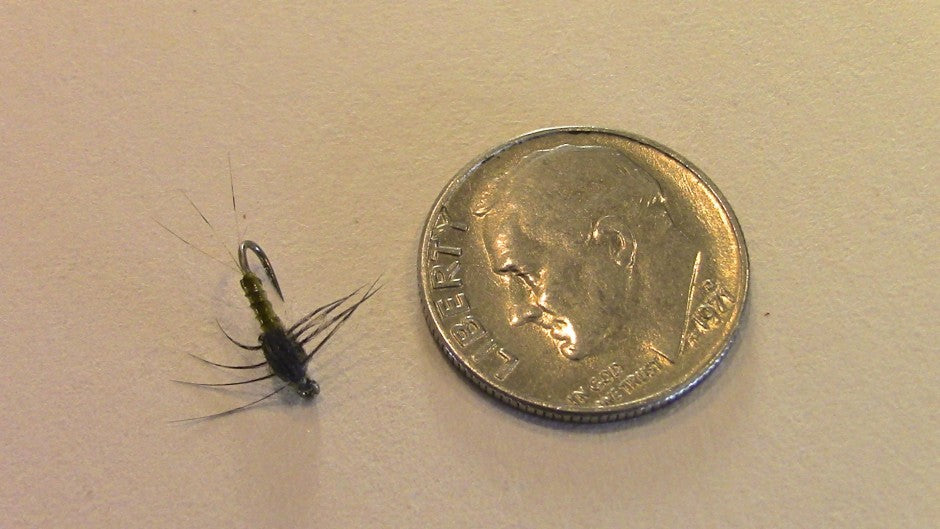I recently rediscovered an article by Oliver Edwards in the British magazine Fly Fishing and Fly Tying. His article was titled- Time to bury the bead? The article discusses the use of beads on flies. Are bead heads on the way out? No probably not, they do continue to work quite well.
However, fish do seem to catch on to bead heads. As an example, on one of our most heavily fished stretches of Rapid Creek, gold bead headed nymphs were deadly when they were first introduced. Nowadays it seems that many fish in this stretch shy away from gold beads. Is this really classic conditioning? Do fish eventually associate getting hooked with eating nymphs sporting a shiny gold helmet? While hard to prove, I do think that this happens in pressured water. So what's the answer?

Here are three Baetis mayfly nymphs collected from Rapid Creek just upstream of Rapid City.
We have had increased luck with black or black nickel beads instead of gold. I rely on tungsten beads for weight on most of my nymphs. So I hate to cut out beads all together. Oliver likes to weight his nymphs as well, but he also dislikes the profile that bead headed flies offer. Oliver's answer to these problems is to "bury the bead". Meaning hiding the bead in the thorax of the fly. I have seen this technique used in the past, but not with the same ingenuity that Oliver employed. If you can get your hands on the March 2013 issue of Fly Fishing and Fly Tying, do so. Probably a long shot unless you order a back issue from the magazine and have it mailed from the UK. Not impossible I suppose.

This bead head nymph prominently features a bead at the front of the hook. This is not a natural profile, nor is the fly by any means realistic. Yet it catches fish! Quite a few for me lately in fact. Will it continue to fool fish when they have been repeatedly caught on flashy bead head flies?
After re-reading the article, I went to the vise and tied up a few of Oliver's Baetis nymphs. These aren't easy to tie on the size 18 hooks that match the length of the baetis nymphs in our streams, but the results are impressive. A very realistic profile, no shiny helmet, and two cleverly hidden tungsten beads. This fly has a much more convincing look and still has plenty of weight. I won't be handing freebies of this fly out to all of my angling friend, due to the fact that each fly takes upwards of 20 minutes to tie. However, I look forward to giving these flies a swim in Rapid Creek soon.
Do we always need realistic flies to fool trout? Are bead heads a bad thing? No. But it's nice to have other tricks up your sleeve when the going gets tough.

One of my attempts to tie Oliver Edwards Buried Bead Baetis Nymph. Top View tied on a size 18 2xl nymph hook

The underside of the same nymph. Two small tungsten beads are buried in the thorax. Oliver hid the beads with yarn or dubbing. I used a very fine amount of dubbing to cover the beads.
A note about Oliver's fly tying style- Oliver flies are works of art, much more realistic than impressionistic. What I have always appreciated about Oliver's flies, is that they are realistic but meant to be fished. His flies aren't stiff realistic patterns that only look good in the vise, they are fishably realistic. Effort is put into making the fly look like the genuine article, but they don't sacrifice the movement that makes the fly look alive in the water. If you have never seen Oliver's flies pick up a copy of -
Fly Tyer's Masterclass - you will be glad you did!
 Here are three Baetis mayfly nymphs collected from Rapid Creek just upstream of Rapid City.
Here are three Baetis mayfly nymphs collected from Rapid Creek just upstream of Rapid City.  This bead head nymph prominently features a bead at the front of the hook. This is not a natural profile, nor is the fly by any means realistic. Yet it catches fish! Quite a few for me lately in fact. Will it continue to fool fish when they have been repeatedly caught on flashy bead head flies?
This bead head nymph prominently features a bead at the front of the hook. This is not a natural profile, nor is the fly by any means realistic. Yet it catches fish! Quite a few for me lately in fact. Will it continue to fool fish when they have been repeatedly caught on flashy bead head flies?  One of my attempts to tie Oliver Edwards Buried Bead Baetis Nymph. Top View tied on a size 18 2xl nymph hook
One of my attempts to tie Oliver Edwards Buried Bead Baetis Nymph. Top View tied on a size 18 2xl nymph hook The underside of the same nymph. Two small tungsten beads are buried in the thorax. Oliver hid the beads with yarn or dubbing. I used a very fine amount of dubbing to cover the beads.
The underside of the same nymph. Two small tungsten beads are buried in the thorax. Oliver hid the beads with yarn or dubbing. I used a very fine amount of dubbing to cover the beads. 
